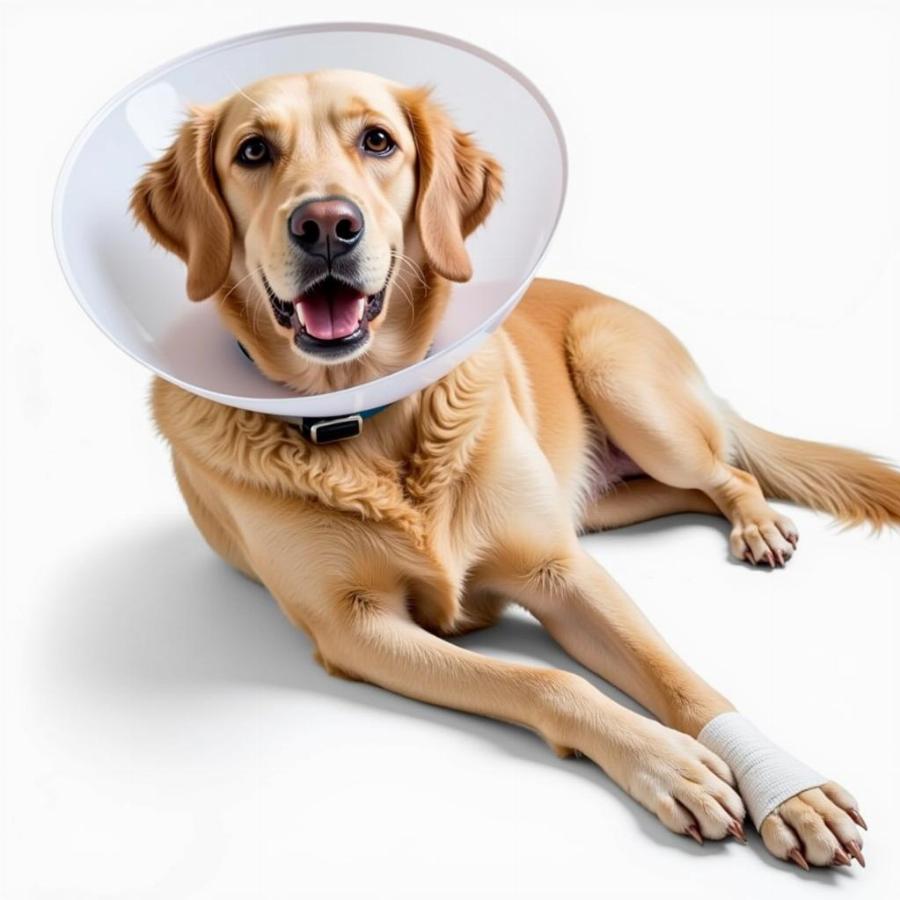Wound care for dogs is a crucial aspect of responsible pet ownership. Understanding how to properly care for your furry friend’s injuries, from minor scrapes to more serious wounds, can prevent infections, promote healing, and ensure their overall well-being. This comprehensive guide will equip you with the knowledge and practical tips to effectively manage various types of wounds in dogs.
Identifying Different Types of Wounds in Dogs
Knowing the type of wound your dog has is the first step in providing appropriate care. Common wound types include abrasions (scrapes), lacerations (cuts), punctures (deep, narrow wounds), and burns. Each type requires a slightly different approach to wound care for dogs, so proper identification is key.
Abrasions:
Abrasions are surface wounds that often result from scraping against rough surfaces. They usually involve minimal bleeding and are relatively easy to treat at home. Cleaning the area with mild soap and water is often sufficient.
Lacerations:
Lacerations are deeper cuts that can result from sharp objects. They often bleed more profusely and may require veterinary attention, especially if the wound is deep or involves underlying tissues.
Puncture Wounds:
Puncture wounds are caused by sharp, pointed objects like nails or thorns. They can be deceivingly small on the surface but can penetrate deep into the tissues, increasing the risk of infection. Veterinary care is often necessary for puncture wounds.
First Aid for Dog Wounds: What to Do Immediately
If your dog sustains a wound, the first step is to assess the severity. For minor wounds, you can administer first aid at home. Control bleeding by applying gentle pressure with a clean cloth. If bleeding is heavy, seek immediate veterinary attention.
Cleaning the Wound:
Once bleeding is controlled, clean the wound with a mild antiseptic solution or warm soapy water. Avoid using hydrogen peroxide or alcohol, as these can damage the tissues and impede healing.
Applying a Bandage:
If the wound is small and superficial, you can apply a clean bandage. Change the bandage daily and monitor the wound for signs of infection. For deeper or more complex wounds, veterinary bandaging is recommended. For some wounds, a liquid bandage dog might be appropriate.
When to Seek Veterinary Care for Your Dog’s Wound
While minor wounds can often be managed at home, some situations require professional veterinary care. Seek veterinary attention if:
- The wound is deep or involves underlying tissues
- Bleeding is heavy or uncontrolled
- The wound shows signs of infection (redness, swelling, pus, or foul odor)
- The dog is in pain or exhibiting other signs of distress
- The wound is located near a joint or vital organ
- You are unsure how to properly care for the wound
Preventing Wound Infections in Dogs
Preventing infection is a critical part of wound care for dogs. Keep the wound clean and covered. Monitor for signs of infection, such as redness, swelling, pus, or a foul odor. If you suspect an infection, consult your veterinarian immediately.
 Preventing Wound Infections in Dogs
Preventing Wound Infections in Dogs
Long-Term Wound Management and Healing
Long-term wound management focuses on promoting healing and preventing complications. Follow your veterinarian’s instructions for wound care and medication. Provide a comfortable and stress-free environment for your dog to aid in their recovery. Using a suitical recovery suit for dogs can also be beneficial.
Nutrition and Wound Healing:
Proper nutrition plays a vital role in wound healing. Ensure your dog receives a balanced diet that meets their nutritional needs. Consult your veterinarian for specific dietary recommendations during the healing process.
Caring for Open Wounds in Dogs
open wound care for dogs requires special attention to prevent infection and promote healing. Keeping the wound clean and covered is paramount. Regular cleaning with a prescribed antiseptic solution and bandage changes are essential.
Conclusion
Wound care for dogs is an essential skill for every dog owner. Understanding the different types of wounds, how to administer first aid, and when to seek veterinary care can significantly impact your dog’s recovery and overall well-being. By following these guidelines, you can ensure that your beloved companion receives the best possible care for their injuries.
FAQ:
- Can I use hydrogen peroxide on my dog’s wound? No, hydrogen peroxide can damage healthy tissues and impede healing. Use a mild antiseptic solution or warm soapy water instead.
- How often should I change my dog’s bandage? Typically, bandages should be changed daily. However, follow your veterinarian’s specific instructions.
- What are the signs of a wound infection in dogs? Signs of infection include redness, swelling, pus, a foul odor, and increased pain.
- When should I take my dog to the vet for a wound? Seek veterinary care for deep wounds, heavy bleeding, signs of infection, or any wound that concerns you.
- How can I prevent my dog from licking its wound? Use an Elizabethan collar (cone) to prevent your dog from licking or chewing the wound.
Beaut Dogs is your go-to resource for all things related to dog care. We provide expert advice and valuable information to help you provide the best possible care for your furry companion. For specific guidance on your dog’s wound care, please contact us at Email: [email protected]. We at Beaut Dogs are committed to helping you navigate the world of dog ownership and ensuring the health and happiness of your beloved pet.